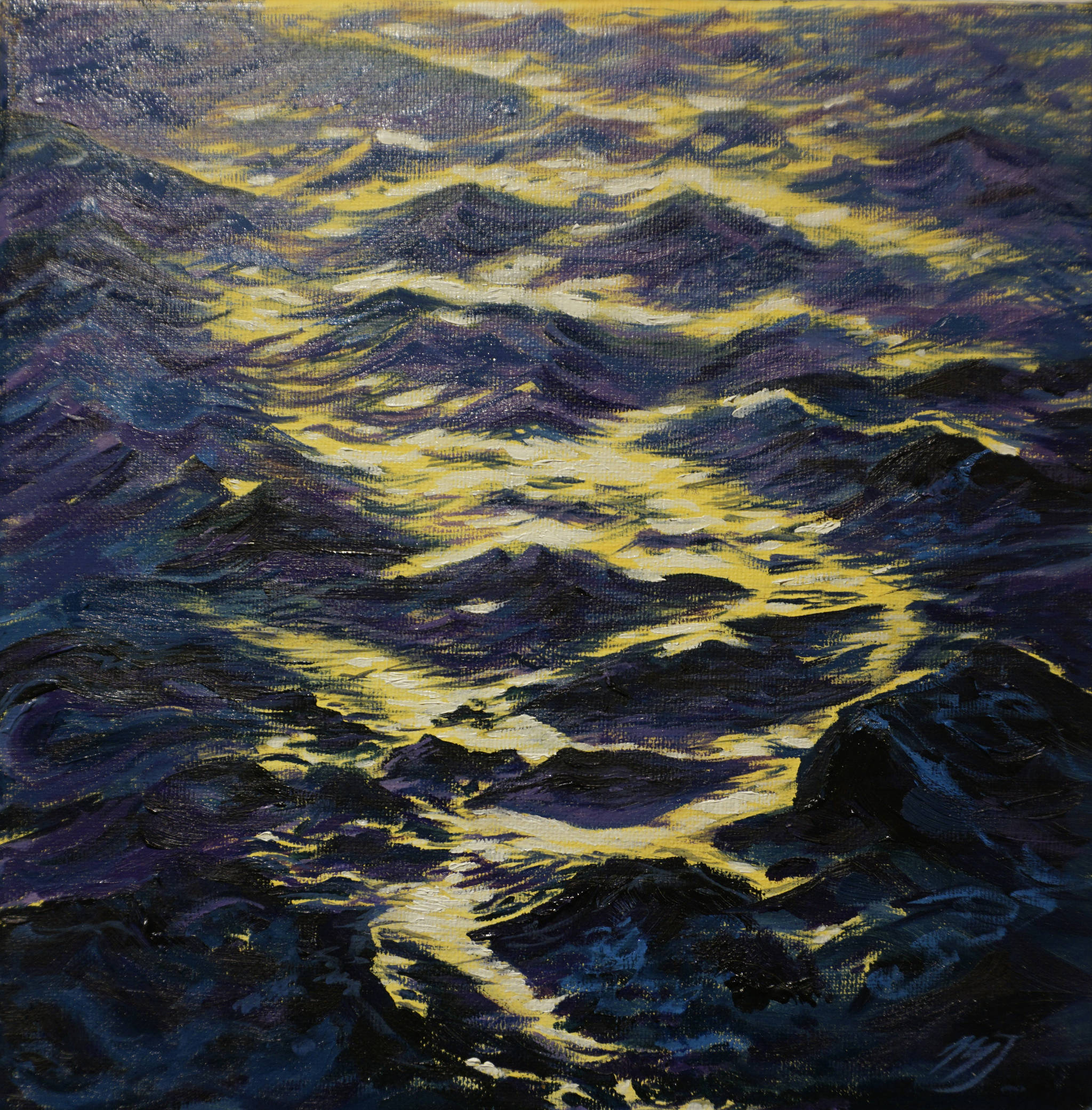Like some other Homer galleries, Bunnell Street Arts Center periodically opens up its walls to community art. With its 10×10 Member’s Show, Bunnell does so with a twist and two conditions:
1) The art must be by Bunnell members, and
2) All art must be no larger than 10-inches-by-10-inches square or 10-inches cubed.
Now in its fourth year, the show draws an eclectic group of experienced as well as emerging artists. While paintings dominate in the show, media includes photography, pen and ink, found objects, fiber art, and even wood burning.
“We’ve enjoyed putting on a show that features a growing number of artists,” said Bunnell artistic director Asia Freeman on Dec. 7 for the First Friday opening. “We’ve felt it’s even better than previous years.”
An open-call show runs the risk of having a mediocre show, but the caliber of work by established artists tends to challenge newer artists to excell. The collection builds bridges between abilities and not walls.
“I feel like the 10×10 show is a really great way to connect with the community, and anybody can,” artist Maria Bernier said during last Friday at the opening.
With 83 works by 43 artists, the opening was a whirlwind of viewing and meeting artists. Bunnell’s openings always feature artist talks, usually informal discussions of the show, the artist’s aesthetic vision and sometimes lively questions.
For the 10×10, Bunnell invited the artists to speak a bit about their work.
Bernier, a student of Freeman in her Kachemak Bay Campus painting classes, spoke about her work, “Chop,” a tight focus on the ocean and waves.
She said she wants to balance realism and impressionism.
For such a small space, Bernier showed how artists can pack a lot of meaning and intensity in their work.
“In this community I feel like we are all connected to the water and have had a moment where we stare at the water and noticed the patterns or the lack of patterns,” she said.
Ann-Margret Wimmerstedt, one of Alaska’s small group of encaustic artists who work with the medium of beeswax, tree resin and pigment, spoke about how bees figure in her painting.
“It’s inspired by a friend who said that all the women I know have been carrying the anger in their bodies and it feels like everybody is going to open their mouths at once and our anger will be released like bees,” Wimmerstedt said. “Bees have always been a part of my work; anger hasn’t been. … Bees represented this thing to me, to release.
“The other part of it is women’s anger has always changed the world and no time like the present.”
Retired clothing designer Jack Packer, who turns 90 this month, showed work with his artist daughter, Sharlene Cline. Packer, formerly of Miami, used to design men’s swimwear.
His pen-and-ink paintings, “Viking 1” and “Viking 2,” have the bold patterns and vivid colors one might see in Miami Beach.
“My past has been a designer of clothing, and I’ve done it for quite a few years and I never knew what I was doing when I started, but it always came out, good,” Packer said of his work. “It’s the same with this one. I don’t know what I’m doing, but I keep on doing it.”
Cline showed one of her Chinese brush paintings, “Poppies.”
“I had a wedding and she (the bride) requested poppies,” Cline said. “Every time I go to do a new subject of Chinese painting, you have to like really be one with the subject, so I have to paint it over and over again. …I have been playing a lot with layering and painting and layering.”
Tattoo artist Sarah Frary’s work graces the body of many Homer people. Her two 10×10 paintings, “Anatomical Landscape,” are companion pieces.
They show a human arm with its veins and muscles looking like a mountain range or ocean waves. She said her main focus on art is environmental concerns and connections.
“It’s hard not to notice that the condition of our landscape is reflective of what’s going on in our bodies as well,” Frary said. “… It was just an exploration. I thought it would be fun to spread it across the two pieces, to feel clinical and visceral and emotional and wrap up all those elements in the painting.”
Some artists spoke about how the 10×10 show allowed them to try new techniques.
Gundega Snepste said she has been playing around with rusty objects and fabric.
“This show is great,” she said. “It’s like little experimentations, little doodlings, so that’s how it came out.”
Freeman mentioned another aspect of the 10×10 show.
Opening this month, it gives holiday gift shoppers an opportunity to buy original art priced between $100 and $300.
People who buy art can pick it up before Christmas, Freeman said — even if they’re buying for themselves.
“That’s the whole idea — promoting local collecting,” she said.
Reach Michael Armstrong at marmstrong@homernews.com.

